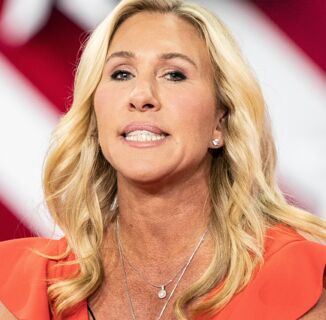The nation’s largest LGBTQ youth organization is standing by a recently released safe sex manual following backlash from conservatives over the term “front holes.”
Critics took issue with the inclusion of the trans-inclusive term in Healthline’s “LGBTQIA Safe Sex Guide,” which was released by the popular health website in July. “Front holes” is commonly used by transgender men who don’t identify with the word “vagina.” Given the term’s close association with womanhood, “front holes” has been widely proposed as a gender-affirming alternative.
But as INTO previously reported, right-wing blogs claimed the presence of “front holes” in the guide is proof that “deviancy is not only being mainstreamed and normalized.”
“The inclusion of this kind of nonsense in what is ostensibly a ‘safe sex’ guide on a mainstream medical information website virtually ensures that this terminology will end up being taught to your child in elementary and middle school,” claimed the website Red State in an Aug. 21 post.
LifeSite further claimed the inclusive LGBTQ terminology is part of an “incessant war on biology, language, and common sense that trans activists are waging in academia, the media, and the political arena.”
But following conservative outcry, the organizations behind the resource guide defended the usage of “front holes.”
GLSEN, one of several advocacy groups which partnered with Healthline, claimed in a statement it was “proud to be a consulting partner” on the safer sex manual, which the national youth organization stated was “specifically designed to be more inclusive of marginalized communities.”
“The guide suggests alternate language that may be more inclusive for some individuals, and can be used in addition to more commonly used medical terminology,” claimed Ikaika Regidor, GLSEN Director of Education & Youth Programs, in a statement shared with INTO. “This language can be used in 1-on-1 conversations with transgender and gender nonconforming patients, medical providers, or between partners.”
“Our society has come to understand that not all bodies are the same and gender is not binary,” he continued. “Inclusive curriculum is about ensuring all students can see themselves, and each other, throughout their education.”
The goal of the toolkit is to, thus, encourage LGBTQ youth to “make informed, healthy decisions about their bodies,” according to Regidor.
As GLSEN’s own research has indicated, it can be difficult for trans and gender non-conforming young people to gain this critical knowledge when they so often lack even basic education on their own identities. Less than 5.9 percent of this group reports that their sex ed classes address topics related to LGBTQ sexual health.
Regidor claimed youth “may not make healthy decisions” when school curricula ignore their experiences.
GLSEN also hit back at allegations that including the word “front holes” was a plot by LGBTQ activists to erase the experiences of cisgender women who prefer the word “vagina” when referring to their anatomy. They claim that recognizing a diversity of experiences “does not negate anyone else’s identity.”
“These attacks are simply a hateful attempt to deny the existence of trans and gender nonconforming youth,” Regidor said.
GLSEN is just the latest organization to defend the trans-inclusive manual following outrage from religious conservatives. Advocates for Youth, a Washington, D.C.-based HIV-prevention group, called it a “valuable resource.”
“Healthline crafted their pamphlet to be inclusive of all types of bodies and all people,” claimed President Debra Hauser in a statement. “[…] Representation matters, and having words that reflect how each of us describes our body parts is crucial to lifelong health and well being.”
Meanwhile, Healthline added that “front hole” is “one of the numerous, accepted terms for genitalia we use specifically for certain members of the trans community who identify with it.”
The terminology is consistent with language suggested by Fenway Health, Human Rights Campaign, National Institutes of Health, and Whitman-Walker. In a 2017 article in BMC Pregnancy and Childbirth journal, researchers suggested clinicians reflect “the language patients use to describe their reproductive organs and bodies” back to them in conversations about their health.
“There is a long history of transgender people facing abuse, objectification, and neglect both within and beyond health care settings,” wrote authors Alexis Hoffkling, Juno Obedin-Maliver, and Jae Sevelius, after discussing the issue with 10 trans men.
“This may frame your encounters,” they concluded.
The Healthline guide’s release follows a similar decision from the British Medical Association, which announced in 2017 that it would be advising medical professionals to refer to expectant patients as “pregnant people” instead of “mothers.”
The change was intended to reflect that trans men can also become pregnant.
But unlike the British Medical Association, Healthline maintained it did not suggest that medical professionals stop using the word “vagina.” Both “vagina” and “front hole” are used interchangeably throughout the manual. “Vaginas” are referenced 17 times, while front holes just are brought up 16 times.
“In no instance in this guide are we saying we want to replace the word νagina,” Healthline clarified.
Images via Getty
Don't forget to share:
Help make sure LGBTQ+ stories are being told...
We can't rely on mainstream media to tell our stories. That's why we don't lock our articles behind a paywall. Will you support our mission with a contribution today?
Cancel anytime · Proudly LGBTQ+ owned and operated
Read More in Impact
The Latest on INTO
Subscribe to get a twice-weekly dose of queer news, updates, and insights from the INTO team.
in Your Inbox












